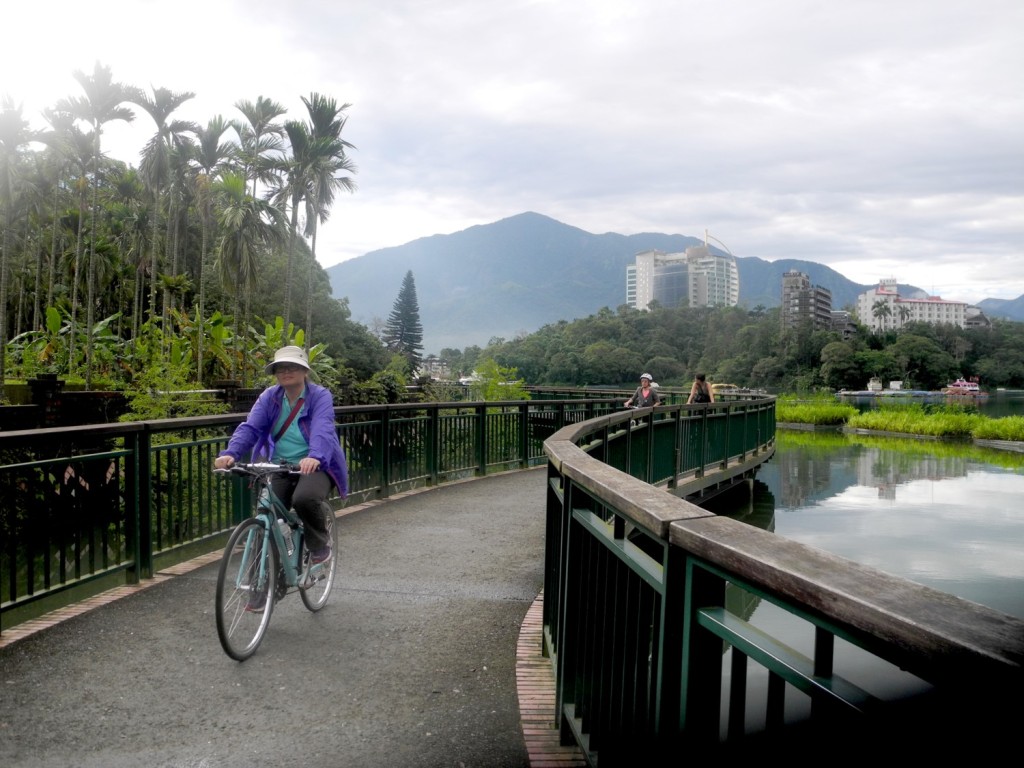
by Karen Rubin
Before I arrived in Taiwan with an intention of biking, I hadn’t realized what a mountainous island this is – not just hilly, but craggy mountains that rise steeply. There are thousands of mountains – 100 peaks are over 3000 meters high. Only 30% of the land area is habitable, the rest are mountains and forests. In fact, Taiwan now hosts an international cycling race that may well be among the most challenging in the world.
Nonetheless, Taiwan is very pro-cycling and has developed a fantastic network for biking – more than 3,000 kilometers of dedicated bike paths all around the island – so that even if you don’t do a point-to-point, inn-to-inn cycling itinerary, you can do a kind of hub-and-spoke or town-to-town, renting a bike in the best spots, and enjoying these marvelous bikeways.
What we experienced during our all-too-brief six day visit inspired me to return to travel more intensely. I discovered what a fantastic destination Taiwan is to really explore – it is such a distinct culture, with such rich heritage, beautiful landscapes, and extraordinarily friendly, good-natured people – and despite the fact that you are likely not able to understand the language or be able to read it, you feel incredibly comfortable and at ease.
I have been longing for a destination to explore as I did as a college student, backpacking through Europe, just discovering things serendipitously.
You can get around Taiwan so easily – by rapid transit train, by bus, rent a car (you need an international drivers’ license; excellent highways with signs in Chinese and English), hiring a car and driver, or signing on to an organized bike trip where you really do go point-to-point.
Another surprise is how remarkably affordable Taiwan is (again, reminding me of the good ol’ days) – prices by my rough estimate are as much as half what you would expect to spend traveling in the US or Europe for everything from bike rental (as little as $2/hour to $7/hour) to food (our average meal at a local restaurant was $10), to hotel arrangements to train travel (an hour’s trip on a high-speed rail was $55).
Taiwan is also surprisingly compact – you can ring the entire country on a nine-day guided biking trip (as long as you don’t stop to sightsee) and yet has such a variety of eco-systems and cultural niches. It is still possible to see an aboriginal village, and meet Taiwanese whose families go back hundreds of years to the Han Chinese including Hakka immigrants from areas Fujian and Guangdong on Mainland China.
Taiwan (named Formosa by Portuguese, “Beautiful Island,” who never actually settled here) was colonized by the Dutch beginning in 1623 (just like New Amsterdam/New York City!) The Dutch did not last long, though, driven out first by loyalist of the Ming dynasty and then by the Qing Dynasty. It was in the hands of the Japanese from 1895-1945.
These influences are still very strong, but the Taiwan we know today reflects the influx of the mainland Chinese in 1949, led by Chiang Kai-shek, who fled the Communist takeover and brought with him as much of China’s heritage as he could organize (apparently, the treasures of the Forbidden City had already been boxed up during the 1930s because of the Sino-Japanese War, so it was relatively easy to get them out).
Like the Taoist temples where Guardians protect the Gods and Goddesses, Taiwan has been the guardian of China’s millennia-old heritage, and even though Taiwan is quite modern, the traditions are very much the foundation.
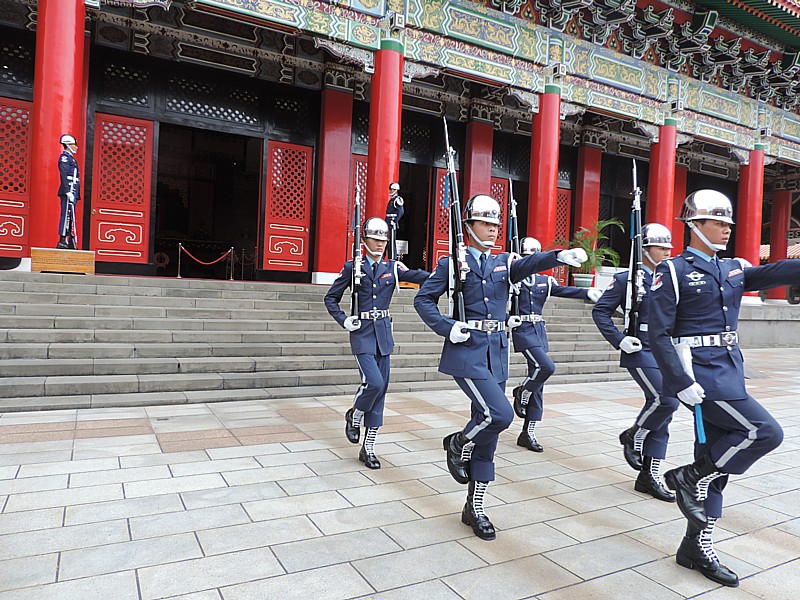
During our first day in Taiwan, in Taipei City, after renting a bike and exploring a popular bikeway in a park along the river, we get an excellent foundation in understanding Chinese and Taiwanese heritage at the National Museum, which houses 650,000 artifacts, most of them the items taken from the Forbidden City in Beijing after the Communist takeover of China. We visit Chiang Kai-shek’s Memorial and the Martyrs Shrine (where a popular thing is to see the changing of the guard, which happens every half-hour) – which provides a foundation for what we will see when we leave Taipei City for other parts.
We could have – should have – done our sightseeing around Taipei with the U-bike, that wonderful urban bike-share program. However, unlike some other cities like New York City and Washington DC which have similar programs, there did not seem to be actual bike lanes – at least bike lanes that weren’t jam crammed with pedestrians or merged in with the hoards of mopeds (there are 10 million mopeds in Taiwan for 23 million people). Hardly anyone was biking in the city that we could see. (The city affords excellent mass transit, by the metro or bus or cab; you can purchase multi-day travel passes for U-bike and the metro and bus).
Old Caoling Tunnel Bikeway
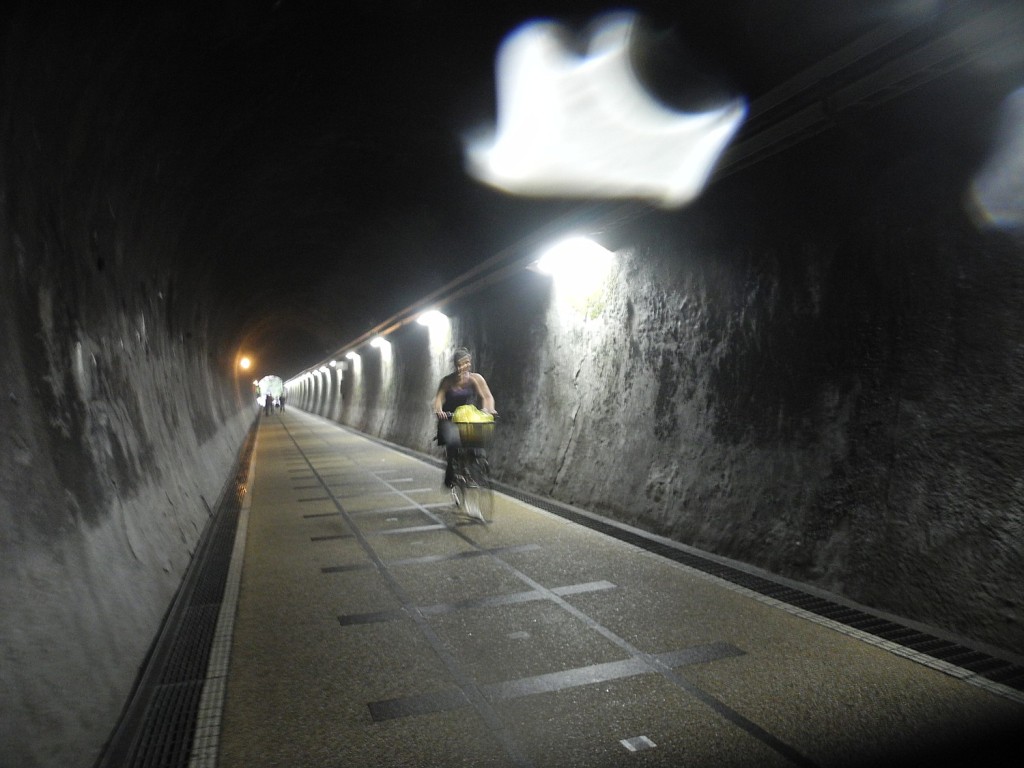
Our first real biking comes when we head to Fulong, on the Northeast Coast, a popular beach and recreation area. Here, you appreciate the dramatic landscape – the ocean on one side which falls off sharply to a deep depth, and mountains that rise straight up on the other side of the road. Tall rocks project out of the water.
The dramatic coastline reflects one of Taiwan’s geological quirks: Taiwan is rising up 0.8 cm every year because of the collision of two tectonic plates.
We come for two magnificent bikeways: the Yanliao-Longmen Bikeway and the Old Caoling Tunnel Bikeway, together among the five most popular bike routes in eastern Taiwan.
The train tunnel was finished in 1924 during Japanese occupation, to accommodate the Yilan Line. At 2.16 km, it was the longest tunnel in Southeast Asia at the time. It was difficult to build – 11 people died and 366 injured during construction. When a new tunnel opened in 1985 for a new train, the “train cave” was abandoned for 22 years. Then in 2007, the government rebuilt the tunnel as part of the bikeway.
The tunnel is well paved, well lighted and as you go through, you hear the strains of a Yilan folk song about a train, which was popular at time the tunnel was opened. The song was banned during the Japanese occupation which banned Chinese traditions. In 1943, a popular Taiwanese singer revived it, reminding the people of their heritage (it strikes me that it is like what the song Edelweiss meant to the Austrians during the Nazi occupation).
The scenery is beautiful – there is a fishing village at the end of the Old Caoling Tunnel route, at which point you get onto the bikeway that goes alongside Highway #2, and can connect with the Yanliao-Longmen bikeway, which affords the special attraction of riding over a suspension bridge over a river, to complete the circle.
The high point of the Yaniliao-Longmen bikeway is going over a suspension bridge.
(This area is accessible by train from Taipei, and there are bike rental shops right at the start of the trail.)
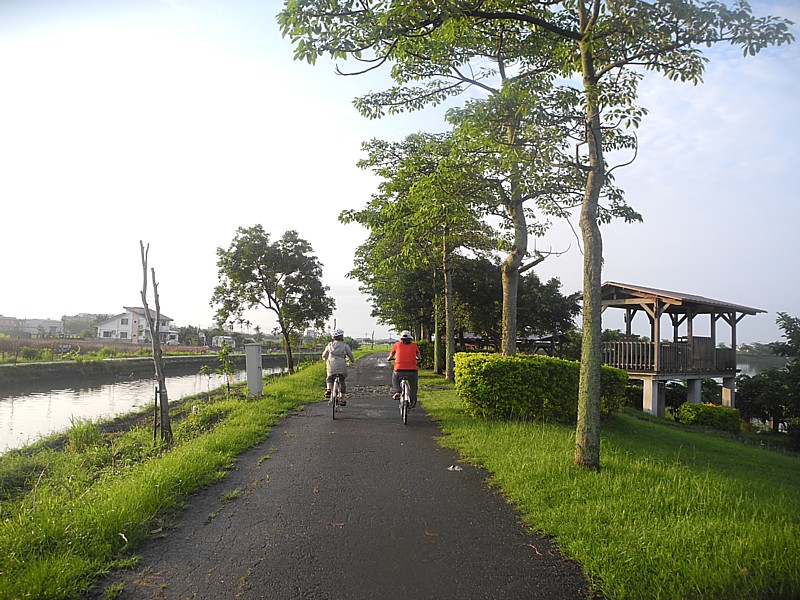
We drive about an hour or so away to another area to experience the biking – Dong Shan River Water Park – and here, we catch a break. Just as we get our bike rentals, the sky clears up and we are blessed with a bit of golden light, a touch of blue sky that adds color to the landscape, and that delicious smell that comes from the bushes after a rain.
This is a bikeway that goes along the Dong Shan River, the fifth longest stream in Yilan province. The bikeway starts in a recreation area that boasts a delightful waterpark, and continues on a berm that has the river on one side, and farms and rice paddies on the other, and then passes by a marvelous heritage park. This entire area caters to tourists with a multitude of attractions, so you can easily spend a couple of days here.
The bikeway we take is only a tiny portion of the East Rift Valley National Scenic Area, which offers several bikeways: the Ruisui Bicycle Path (9.7 km); Depo Pond Bikeway (8 km); Yuli Bikeway (9.5 km); Liyutan Bikeway (this features the Tanbei Water Park and Taiwan fisheries Research Institute, 5.2 km); the Guanshan Town Encircling Bicycle Path (13 km); and the Longtian Bike Path (this features the Benun Tribal Leisure Farm, 5.2 km) – all of these hare connections to railway stations and rental shops.
Alas, we had all too brief time in this area.
We complete our visitor experience at the Yilan Evergreen Phoenix Hotel (www.evergreen-hotels.com/jiaosi) – a gorgeous spa hotel which has its own rooftop hot springs pools and outdoor swimming pool that is fabulous for laps, beautifully landscaped and absolutely heavenly at night (it is open until 11 pm).
King of the Mountain
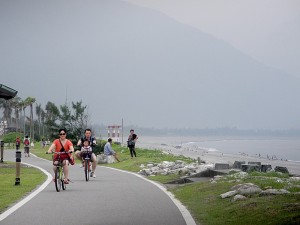
Our next day, we experience a pleasant bikeway along the Chihsingtan Beach in Hualien, that follows a half-moon shaped gulf and draws thousands of tourists (it also butts up against an Air Force base and there are military installations that are presented as a “hidden military treasure”). I follow the bikeway further, to a high pavilion with a view of the beach, and then continue on to where the bikeway comes out into the city but is not worth the effort.
Our purpose here, though, is to see the starting place for one of Taiwan’s most important international bike races, the KOM (King of the Mountain), which is held in November. This is the starting point, at zero-elevation, and the race, probably one of the most arduous in all cycling, proceeds for 100 km, virtually straight up, through the breathtakingly beautiful Taroko Gorge, through the valley to the 3275 meter high peak of Mt. Wuling where the race ends. During our trip, we will trace the route.
Taroko Gorge
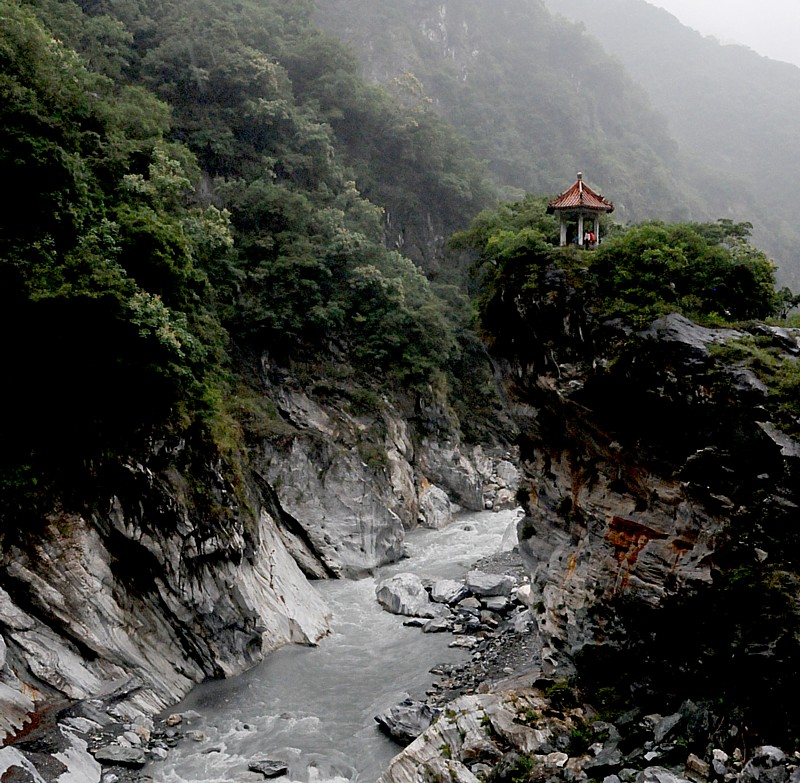
We originally thought we would get to sample biking at the Taroko Gorge – but that is before we actually saw it and what the road would be like. The scenery is beyond spectacular, and so is the road.
In order to bike here, you would have to do it very early in the morning (like 6 am), and if doing a point-to-point trip, you would do it from the north-to-south, which would be downhill (which is how the bike tours do it).
There are several hostels and lodges in the park which cater to hikers, climbers and bikers. We stay at Silks Place Hotel, a luxury resort hotel that is utterly fantastic, and is in close proximity to a fascinating Buddhist temple and fabulous hiking trails. They offer some rental bikes, as well as guided hikes (www.silksplace-taroko.com.tw).
See: Taroko Gorge tops Taiwan’s natural wonders and slideshow
Silks Place Hotel, which is at the other end of the Taroko Gorge from Chichsingtan Beach where we start, is only about one-third the distance of the KOM, and only at about one-fifth the elevation, at 600 meters, in the in the climb up to the peak, where the race would end, in Oiling, at 3,275 meters high.
Now comes the more challenging part. Even driving on these roads is treacherous – and also nauseating (Advice: take ginger candy to suck on, Tums, or Bonine or motion sickness medicine before you head out). We actually see bikers along the road, and I think about the advantage that the local riders must have in the race.
We go through a multitude of tunnels – the engineering is fascinating, along with the plethora of suspension bridges that criss-cross the Gorge. The mist is rising – so the view is constantly changing -the scene opens and closes.
The biking through the Taroko Gorge (all part of the KOM race) is tough enough, but this part, in the valley, is much more extreme – rising steeply, narrow turns, single lane and no shoulder.

At about 2000 meters elevation, needing a break and some fresh air, we stop at Pilou Sacred Tree (also known as Bilu Divine Tree) rest stop, where the fellow (who now lives in California but comes back for summer to work in his family’s cafe) gives us a hot, black, syrupy drink, Lon Gan Ginger sweetened with brown sugar, that is supposed to help settle the stomach. When that doesn’t work, he offers us a straw mushroom with salt. (I take Tums).
It is a most pleasant spot – and what a view, even with the fog filling the valley. It’s the view and the crisp, cool air – such a contrast to the hot humid weather down below – that makes us feel better.
The delightful cafe sells peach honey which they make; and the menu features such items as pig’s knuckles with peanuts and a Lily flower and mushroom soup (50 NT, about $1.75)
The sacred tree that the rest stop is named for stands just beside the road – 3200 years old and still living.
Our guide tells us that this road has some of the shortest, steepest climbs probably anywhere, and reminds us just how mountainous Taiwan is (and now we can appreciate it) – with thousands of mountains and 100 mountain peaks above 3000 meters. They are known as the “Top 100” and a goal for Taiwanese is to do the Top 100 in their lifetime.
The KOM race is now striking me as an absolute phenomenon, one that should stir the same kind of awe and attention as the Tour de France and the Hawaii Ironman Competition. Though a traditional event locally, it has only recently become an international event with professional riders.
The road is unrelenting in how it rises in elevation, and the twists and turns come even more sharply. Out of the 400 racers invited to KOM in its first three years, only about 100 finish – incredibly in three hours.
The last mile is the hardest for the riders – rising at a 17% grade. Now we are above the tree line. There are a couple of hostels in the area that serve mountain climbers and hikers and a research station. At He Wan Mountain, there is a hiking trail that takes about 40 minutes to “conquer” the summit.
The temperature has dropped significantly, as well – Taiwan is sub-tropical, but now we put on light jackets. It is also terribly foggy. In winter, there can be snow here.
We pass the 3158 Cafe (3158 meters elevation), but we are still not at the summit.
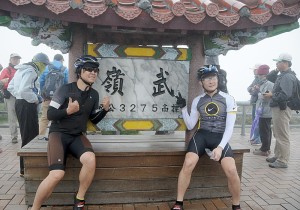
It is absolute fog when we get to the peak – you can’t see far, but everyone, including a couple of bikers, is delighting in taking pictures at the sign that gives the 3275 meter high mark – a man offers to take my picture for me.
It has taken us 3 hours to drive here (with stops), from 8:30 to 11;30 am, and we started out one-third of the way from the start of the KOM – it takes the winning cyclist 3 hours to complete the race.
The race is so challenging – the road so narrow – that the road is closed and spectators are not allowed along the route. However, if you are staying in the Silks Place Hotel or Leader Village Hotel the night before the race, you can get to see the race on the road (though you are also confined to where you are for the duration). Another way to watch the race is to go from Cingjing, Nantou to Wuling and see the cyclists rush through the finish line.
Sun Moon Lake
It takes another three hours for us to drive to the Sun Moon Lake National Scenic Area, in the heart of Taiwan. We get a glimpse of this absolutely stunning lake, but just as we arrive at the Giant Bike Rental Shop, the sky literally opens up, sending down a deluge.
It’s late afternoon and we go to our hotel, Puli Yoou Sham Grand Hotel (www.yooushan-hotel.com.tw) – which is not in the Sun Moon Lake tourist area (it is the weekend and filled with people) – but in Puli, which is proud of being “the heart of Taiwan” in the center of the island. The Puli Yoou Sham Grand Hotel is a four-star hotel that is popular with local people – it has a marvelous outdoor pool, a fitness room, a rooftop revolving restaurant, and that evening, have dinner at Ya Zung Haka restaurant to experience Haka-style cuisine.

We return to Sun Moon Lake the next day, just after the Giant rental shop opens at 6 am, and enjoy a magnificent ride along one of the prettiest bikeways anywhere. At points, the bikeway doesn’t just ring the lake, but actually goes along bridges just above the lake’s surface – a magical experience. We only have time to do the 7 km-long bikeway, but it is also possible to ride around the lake on the road, a total of 33 km.
There is a lot for people to enjoy: just near the lake is the Formosan Aboriginal Culture Village, an amusement park that has been opened since 1986, which has the tallest freefall ride in Taiwan.
Also, the Sun Moon Lake Assam Tea Farm, where visitors can learn how to pick up tealeaves and have tea-tastings.
The area is also popular for bird watching and hiking up to the peaks that seem to rise from the lake shore.
Cycling Taiwan
We’re here on a survey mission organized by the Taiwan Government Tourist Office, which has focused on promoting cycling for locals as well as visitors. And these are just a sampling of the fabulous bikeways – all of them in areas rich in cultural and natural attractions that warrant exploration – so that I am anxious to return and really spend time exploring. The bikeways are extremely well marked (in English as well as Chinese), with rest facilities and services (there is always a Western style toilet, even if it is the “disabled” toilet).
The bikeways are delightful for any level of rider and any age and we see scores of families with kids in carriers and bikeseats; road riding would be a different story.
The best bike rentals were to be had at the Giant bike store outlets – this is the major bicycle manufacturer that also has a network of bike rental shops (what better way to promote the product – I know I wanted to buy one) and have outlets in the best biking areas.
Giant also operates a whole catalog of multi-day, point-to-point guided biking tours of Taiwan – perfect for more intense cycling. The Giant tour planners know where it is safer and where it is dangerous to ride; the groups go out with two mini-vans – one in back and one in front. They put you into groups, not necessarily English speaking, and trips average $169 per person/per day More information on Giant Travel’s website: www.giantcyclingworld.com/web/travel_en.php
We also found a wonderful itinerary marketed by biketoursdirect.com, which is operated by SpiceRoads, and really covers Taiwan’s highlights, including spending two nights in Taroko Gorge, so you have a full day to hike and explore (www.biketours.com/Taiwan/taiwan-traverse-by-road-bike#sthash.rE3jN2HZ.dpuf)
Bike tours are also offered by:
Grasshopper Adventures, www.grasshopperadventures.com, 818-921-7101, Email: journeys@grasshopperadventures.com (http://grasshopperadventures.com/tour-TSCB09.php
Bicycle Adventures, bicycleadventures.com, 800-443-6060 (bicycleadventures.com/destinations/taiwan-bike-tours/Taiwan-Bike-Tour—NEW!)
Green Island Adventures, www.greenislandadventures.com/cycletours.htm
A superb guide, “Cycling Taiwan: Great Rides in the Bicycle Kingdom”, details the routes, and access information – 26 bikeways in 12 national scenic areas including 25 family-friendly routes – several that we experienced, and many more that will have to be put off for another visit – like the Wushantou Hatta and Baihe bikeways in the Siraya National Scienc Area; the Aogu Wetlands and Beimen bikeways on the southwest Coast; the Anpo Tourist Cycle Path in Maolin and the Shimer-Changbin Bikeway, Sanxiantai Bike Route which are highlighted by indigenous culture.
You can find superb itineraries at “MyTaiwanTour”, www.mytaiwantour.com.
Expect to pay a per diem of $166 (about half of what bike trips in Europe cost).
Our visit has been too brief, but has piqued my interest to return and really explore. I found Taiwan to be a destination which you can really do that – the logistics and excellent transportation systems, the variety of landscapes, the depth of its cultural attractions, the superb accommodations and food, and the excellent value for money (a bargain destination, I would venture to say), and most importantly, how comfortable you feel everywhere you go. It may seem cliche, but the people really are friendly, hospitable and so anxious to help even if they do not speak English.
Prepare for the trip in advance:Tourism offices in the US include: Taiwan Visitors Association, 1 East 42nd St., New York, NY 10017, Tel. 212-867-1632/4, Email tbrocnyc@gmail.com
See also:
Travel to Taiwan: vibrant, modern society built on bedrock of tradition and slideshow
Taroko Gorge tops Taiwan’s natural wonders and slideshow
2 Days in Taipei: Hitting the highlights and the highpoints in Taiwan’s Capital and slideshow
Dining on Xiaolongbao at DinTaiFung at Taipei 101 is savory experience and slideshow
Two Days in Taipei: Day 2: Confucius Temple to Fine Art Museum to Night Market and slideshow
Chinese Arts Dancing Ensemble and slideshow
_______________________________
© 2015 Travel Features Syndicate, a division of Workstyles, Inc. All rights reserved. Visit www.examiner.com/eclectic-travel-in-national/karen-rubin, www.examiner.com/eclectic-traveler-in-long-island/karen-rubin, www.examiner.com/international-travel-in-national/karen-rubin, goingplacesfarandnear.com and travelwritersmagazine.com/TravelFeaturesSyndicate/. Blogging at goingplacesnearandfar.wordpress.com and moralcompasstravel.info. Send comments or questions to FamTravLtr@aol.com. Tweet @TravelFeatures. ‘Like’ us at facebook.com/NewsPhotoFeatures.

